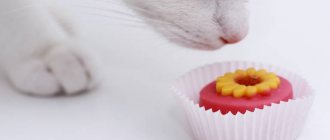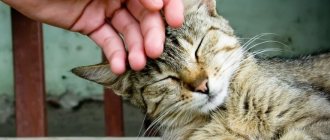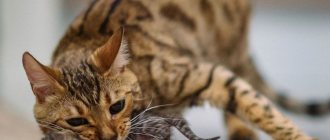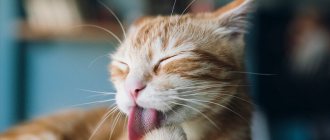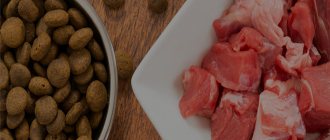- What should you absolutely not give to your cat?
- Dry food or meat?
- If a cat doesn't eat meat, what should you feed it?
- Animal care tips
The cat is one of the most popular pets in the world. She acts like a friend, companion, neighbor, and even an assistant to us in some matters, and most importantly, she is the keeper of all our secrets. Some difficulties arise in the lives of our beloved pets and nutrition is one of them. Yesterday a friend asked me: “Do you know why the cat doesn’t eat meat?” and described my problem. I shared everything I knew. I’ll share it with you too, because you probably have a furry companion at home.
What kind of raw meat is suitable for a cat?
Meat for cats is a necessary product in the diet, and raw food is the best for the animal.
Digestion of raw meat occurs due to the high level of acidity of gastric juice. Not all types are suitable for cats. The ideal option would be the meat of cattle, goat, horse, sheep, rabbit, chicken, and turkey. Offal is suitable for animals in moderation (you should try not to overfeed your pet with it). The maximum amount of offal should be 200 g per week. Meat is purchased exclusively fresh, since expired product causes various diseases in the pet. In your pet's menu, approximately 75% of all meat should be raw.
Some veterinarians do not recommend giving pets large amounts of beef. They refer to the statement that under natural conditions a cat cannot hunt a cow and, most likely, the cat's stomach is not capable of digesting beef. But not everyone agrees with this statement.
It also happens that a pet is not accustomed to eating raw and unprocessed meat from childhood. A similar phenomenon occurs among finicky individuals or those who have been fed dry food or boiled foods for a long time. A cat may be suspicious of raw meat if it is the first time it has seen this product.
Sometimes cat owners try to feed them to little chicks. This is not practical. Such food causes pathological changes in the body. Cats need high-quality natural meat without biological additives, hormones or antibiotics.
Pottenger's Experiment Explained: Can Domestic Cats Eat Raw Meat?
A large statistical sample and the duration of the experiment allow us to speak about its reliability.
The conclusions are clear: cats fed raw meat are healthier than their counterparts fed thermally processed food. Of course, during Pottenger’s experiment there were also individuals who did not suffer from health problems as a result of eating thermally processed foods in the first generation. These were exceptional cases, indicating extreme genetic resistance to diseases of individual cats. But why does this happen? Why do raw foodists live longer and happier? There are scientific explanations for this, although they were not known in Pottenger’s time. Pottenger only suggested that the whole point is in the heat treatment of the protein, as a result of which some important substances are lost. Today we can talk about this more specifically. Modern science calls the process of protein losing its qualities during heat treatment the word “denaturation.” Denaturation of meat proteins begins at a temperature of 30-35 degrees Celsius, and at 65 degrees about 90% of the proteins are already denatured.
Denaturation is a change in a protein molecule under the influence of destructive factors, leading to the protein losing its original properties.
During heat treatment of meat the following changes occur:
Article continues after advertisement
- When boiling, taurine is destroyed - an amino acid necessary for the construction of tissues, especially important for the cat’s heart: the cat’s body cannot synthesize this amino acid and must only be obtained in finished form from meat.
- Collagen, important for the construction of tissues, turns into glutin (animal glue, devoid of a number of important amino acids) and gelatin - destruction of collagen fibers occurs, their breakdown into separate peptide chains. Gelatin, which is acceptable and even useful in many ways when used by humans, is much less suitable for predators: it does not have a complete amino acid composition, moreover, it is prohibited for a number of diseases, the presence of which cat owners may not know for the time being, and therefore continue give products with gelatin. In addition, gelatin, when used regularly, can cause increased cholesterol levels, constipation, irritate the mucous membranes of the gastrointestinal tract, and much more. So jellied meats, meat extracts and other products with artificially isolated gelatin are a big question in cat nutrition.
- Important substances (sodium, potassium, chlorine, magnesium, calcium, iron, iodine, copper, cobalt, manganese, fluorine, lead, vitamins, etc.) are partially or completely destroyed during heat treatment. Some substances are destroyed slightly, and some are destroyed by 30-100%, that is, they disappear almost completely. Thus, vitamins C and D are significantly destroyed, vitamin A - by 30%, group B vitamins are destroyed even more (but each has its own level of resistance to temperature), vitamins E and K remain. Many minerals are destroyed by 25-60%.
- Loss of fat nutrients occurs.
- If meat with a bone is subjected to heat treatment, then the calcium from the bone passes into an indigestible form, and the bone itself becomes dangerous, because The cat's stomach is no longer able to digest it. This creates a risk of injury or blockage of the digestive tract with undigested bone fragments.
That is, in fact, boiled meat is almost empty calories, providing energy, but practically no vitamins and minerals in a form accessible for absorption. Therefore, such nutrition must be enriched with vitamin and mineral complexes, which for the most part are absorbed much worse than natural ones and can cause side effects.
Adding raw vegetables to food to enrich your diet with vitamins and minerals is pointless, because... Cats have a protein-fat metabolism: they absorb almost nothing from plant foods.
At the time of Pottenger, all these theses were just an assumption, which he confirmed experimentally. Of course, a diet based on boiled meat did not involve enriching the diet with any additives other than cod fat. Modern cats fed on thermally processed foods also have the opportunity to receive vitamin and mineral complexes. But, as already mentioned, they have side effects, they can easily create hypervitaminosis, and they are not equally suitable for all cats. Therefore, the ideal and universal diet is raw meat, which already contains everything. And such a diet is much cheaper.
Raw chicken in a cat's diet
Let's take a closer look at the nuances of feeding chicken. Of the variety of meat products, a cat cannot:
- Fat meat.
- Raw and fatty pork (can serve as a source of false rabies).
- Lamb is too fatty.
The ban also applies to any kind of semi-finished products, including canned meat and fish.
Let us immediately outline a number of nuances:
- The meat must be fresh.
- The point of sale must have documents for the products and veterinary control certificates.
- Cats can eat chicken meat and offal.
- Cats are not allowed chicken bones, heads, or paws.
Having consulted breeders, we can conclude that chicken is a universal product. Many experts start feeding kittens with ground chicken, more precisely, fillet (breast). The experience of the owners only confirms the opinion of breeders; many feed their pets boiled chicken every day. There is controversy about raw foods.
Let's start with the basics - chicken meat needs to be separated from bones, skin and fat. Leftovers cannot be used to prepare broth, especially when it comes to factory-made carcasses.
Many meatpacking plants "pluck" chickens with acid (which is absorbed into the skin of the bird) and keep the carcasses in a saline solution to prevent them from spoiling as quickly. How else can you ask? Believe me, there are permitted methods of processing meat and the above do not apply to them. In addition, when buying salted carcasses for a neutered cat, you risk his health. It is known that a sterilized cat and a neutered cat should be kept on a low-salt or salt-free diet.
Raw meat takes longer to digest, but the degree of saturation with it is greater. Feeding too much raw chicken can lead to diarrhea. Another nuance that is not taken into account by many owners is the risk of parasite infection. If you give raw meat, it should be deeply frozen. That is, the chicken is cut into portions and frozen. After 2–3 days, the portioned piece is removed from the freezer, defrosted and crushed for feeding. There are different opinions about the dangers and benefits of microwave ovens, but if you rely on the facts, heating in the microwave is a weak, but heat treatment. What to do with the liquid that drains from meat during defrosting. It’s better to pour it out, and if there is a lot of water, then you shouldn’t buy any more products from this manufacturer.
What to do with the risk of infection with worms? Chicken meat is not a source of very dangerous parasites, so regular prevention will solve all problems.
The next point is chicken, it is not only meat, but also offal: liver, heart and stomach. In terms of preparation for consumption, everything here is similar to meat, but there are nuances associated with the volume and frequency of feeding. Raw liver weakens, but boiled liver strengthens the cat’s intestines, that is, both constipation and diarrhea are possible. If your cat has not eaten chicken liver before, you need to introduce it into the diet carefully and gradually. The heart and stomach are muscle tissues that are difficult to digest. Both products can be given raw (after peeling, freezing or boiling water), but must be thoroughly chopped.
If your cat doesn't eat raw meat
Many owners are perplexed when they see that their cat ignores the offered meat. This situation occurs especially often when trying to switch a cat from dry food to natural food. It is worth understanding that if a cat has never tried raw meat, then it will be difficult to provoke it to take such a decisive step. Instincts are on your side, every predator knows the smell of meat a priori, the question is whether store-bought chicken smells like it.
For the first test, it is better to purchase poultry. The bird smells the freshest. It is strictly not recommended to start getting acquainted with meat products with the liver. Quite often, a cat can be provoked to take the first step by eating boiled meat in front of it. If the pet approves of the processed product, you can take the next step. A raw piece of meat should be cut into small pieces and doused with boiling water (so that they whiten a little). The cat will smell the familiar smell of cooked meat, but will taste raw meat. Next, instincts will take over.
What should you absolutely not give to your cat?
Some foods are absolutely contraindicated for cats. And there are good reasons for this. Feeding such food is fraught with serious consequences, including death. The fact is that such nutrition kills the body and contributes to the emergence of many diseases.
- milk – no matter how strange it may sound, milk should not be given to cats. This is because only kittens under three months old are fed with milk. Milk contains lactose, which adult cats cannot digest, resulting in digestive problems. Sour cream is also prohibited. This is too fatty a product;
- fish - frequent eating of fish can result in a cat becoming deficient in vitamin B1; the enzymes contained in fish destroy it. Mood swings and loss of appetite are possible. Also, fish causes problems with the kidneys, liver and urolithiasis;
- potatoes and white cabbage – potatoes contain starch, in large quantities it is harmful to the cat’s body. And cabbage causes bloating;
- raw meat - like all raw meats, has many parasites, including worms. Sometimes a cat won't eat raw beef, probably because it knows it's harmful.
- bones (chicken, fish, meat) – bones can get stuck in the throat, damaging it and other organs.
- mahar - causes diabetes, dental problems and excess weight. What is important is that it weakens the immune system;
- garlic and onion - both products contain disulfide, which destroys red blood cells, causing blood diseases.
We have figured out what absolutely cannot be given to cats, because such food brings a lot of troubles and problems. But why doesn’t the cat eat meat, but only food? After all, meat is much tastier than dry food and healthier.
Watch a video about foods you should not feed cats.
How often to feed meat, and in what quantity?
Meat is the most important product in the diet of a domestic carnivore. It must be given to the cat every day. According to generally accepted standards, 80-90% of a pet’s daily diet is meat.
The amount of product to feed is calculated individually, depending on the age of the cat and its activity.
On average, kittens need 30g of meat per day, adults – about 100g. If the cat is overly active and spends a lot of time playing outdoor games, you can slightly increase the dosage of this product.
But, in order not to harm your pet’s health, we still recommend that you first consult with a veterinarian, who can accurately determine the norm for feeding your cat with meat products, taking into account its age, weight and activity level.
And remember, proper feeding is the key to a long and happy life for a domestic cat in your friendly family!
Transition process
We always start with one type of meat. This does not depend on whether the cat immediately switches to raw, or whether he is transferred in stages through baked and boiled. We introduce one type of meat once a week and watch the reaction. If there is no allergic reaction (it can manifest itself in the form of vomiting, scratching, hair loss, etc.), then the product is suitable. If a negative reaction is observed, we cancel the product and do not use it again.
New products can be introduced to kittens more often: once every 3-4 days, because their metabolic processes proceed better - and allergies, if any, will become noticeable earlier.
While the cat does not know how to eat meat, we cut it finely. Then, when the meat becomes a familiar product, it can be served in large pieces so that the cat can tear off as much as necessary and thereby develop the jaw muscles, and also realize the predatory instinct.
However, when switching to a non-raw diet after feeding, problems may arise. The digestive system of cats that consume food works somewhat differently. Firstly, the concentration of gastric juice is lower, because high acidity is not needed for feed processing. Secondly, other digestive enzymes work. Thirdly, the food is not whole pieces of meat, but an already ground mixture. Accordingly, more effort is needed to digest meat. All this can cause unexpected reactions during the transition period until the digestive system is rebuilt.
All these ingredients fit into small dry pads
Cat vomits meat
This may indicate intolerance to the product. In this case, it is better to refuse this type of meat. However, if the pieces were too large or the cat overate, vomiting may mean that the meat needs to be cut smaller at first and not given so much.
Anticipating the question about infections, let's say that situations where a cat gets sick from raw meat are rare and are associated with the fact that he was offered a low-quality product from a spontaneous market, from private sellers or hunters, or not frozen. If your cat eats low-quality meat, she is at risk for gastrointestinal infections.
The cat has diarrhea after eating meat
In some cases, when the digestive system cannot cope with a meat product, because... After feeding, it does not work at full capacity, and diarrhea and indigestion may occur. Again, it is recommended to reduce the portions and cut the pieces smaller.
Also, in case of such problems, it is recommended to first boil or bake the meat to make it easier to digest. But this is a temporary measure, which should be abandoned later, when digestion returns to normal.
The cat has gas
Flatulence can become a constant companion for a cat during the transition period. More often this happens not so much from a meat diet, but from a mixed diet, while the food has not yet been stopped. A couple of weeks after eliminating the factory food from the menu, everything should return to normal. But if a month has passed since the cat was on the natural diet, and gases are still terrorizing the whole family, it is worth consulting with a veterinarian.
Attention! Mandatory Precautions
It doesn’t matter whether you give your cat raw, frozen or boiled meat - if the animal receives natural feeding, it should be regularly checked for helminth infection. You can give medications against parasites prophylactically, but remember, these are still potent drugs, they are harmful to the cat’s body (helminths are just much more harmful, you have to choose the lesser of two evils)
Therefore, if your financial situation allows, it is better to check the cat at the veterinary clinic once every 2-3 months, and if parasites are detected, fight them.
No method of processing meat will provide 100% protection against parasites; in addition, helminths can enter the animal’s body in different ways. Even an indoor cat that never goes outside and eats only dry food is not immune from this unpleasant phenomenon.
What to do if the cat does not eat raw meat?
If an animal is not accustomed to eating raw meat - for example, it previously ate dry food or boiled meat - it may refuse it. Some animals, when they first see a raw product, are suspicious of it, since meat, especially poultry, is quite viscous.
To help the animal get used to the new diet, you can use small tricks. For example, scald meat with boiling water after defrosting or place it in the microwave for a couple of minutes - it will smell like boiled meat, and its surface will become less viscous. Gradually the cat will get the hang of it and the need for such “disguise” will disappear.
How to keep meat safe
It is recommended to properly prepare the product before dacha. This way it will be possible with a high degree of probability to protect yourself from dangerous worms entering the body. You can destroy eggs by soaking meat. The same applies to freezing, especially for a long time. Even the most resistant types of parasites cannot withstand the destructive effects of frost.
After the cooling procedure, you can give the meat to your pet without worrying that it will harm him. When freezing and further storage, the temperature in the freezer should be maintained at a level of at least -12º. Such conditions contribute to good freezing and elimination of pathogens.
If meat was bought on the open market, flies could land on it, carrying harmful bacteria and worm eggs. It will also need to be processed - doused with boiling water. There is no need to keep it in boiling water to prevent the beneficial substances from being destroyed. It’s even better to freeze the product after the procedure and then give it to the animal. In this case, you can be sure that the food will be 100% safe.
Convenient plastic containers are used for freezing. They are best for freezing and preserving the product. Defrosting can be accelerated by exposure to ultraviolet radiation. Cooking will also protect a portion of meat from parasites and bacteria. But it will contain much less useful substances, in particular taurine. Denatured protein is much less easily absorbed by the cat's body.
Meat for castrated and sterilized
As you know, it is very important for cats after sterilization and cats after castration to choose the right diet for feeding. After such operations, great changes occur in the animal’s body, metabolic processes slow down
With improper feeding, there is a high probability of developing certain diseases that significantly worsen the general condition of domestic cats.
After sterilization, cats can be given lean meat, but only in raw and frozen form! The boiled product is not particularly beneficial for the body of operated animals. In addition, boiled meat can provoke protein intoxication, a very dangerous condition for cats.
Portions must be dosed and served fresh. You can also add some types of offal in small quantities to the menu.
The cat should not be given a supplement, even if he really asks for it. The restless appetite of a castrated animal often leads to obesity, as a result of which the cat develops other unpleasant health problems.
Standard cat diet
Everyone knows that cats are carnivorous animals, that is, it is normal for them to eat meat. In nature, animals do not prepare their own food, they eat what they managed to catch along with wool, bones and entrails. If we are guided by this argument, then all the rules for keeping pets will lose their relevance.
The truth is that our domestic cats have long moved away from wild ways of life, although they have retained excellent hunting skills. As before, tailed animals need meat, but in addition to it, cats can receive a number of varied, tasty foods, vitamin supplements, treats and industrial food.
Industrial diet
Let's briefly look at industrial feeds. The option preferred by many is “drying”. There is no doubt about it, dry food is convenient, easy to store, dose, and most importantly, there is no need to prepare it. In addition to drying, manufacturers offer semi-moist food and canned food that can diversify your pet’s diet.
When choosing food, it is important to understand that products are divided into classes:
• Economy is the cheapest food, not recommended for daily use.
• Premium and super-premium – the middle price segment for everyday feeding.
• Holistic – special or medicinal foods used for urolithiasis (urolithiasis), food allergies and other ailments.
The choice of brand, line and type of product is an individual matter. Naturally, it is better to focus on manufacturers with a good reputation and products of original quality. What you should not do is mix industrial food with natural food. If you decide to feed your cat chicken and dry food, you will not see particularly serious consequences, at least not immediately. However, be aware that you are putting your cat's body at a crossroads. Her digestive system can digest either food or chicken, but cannot digest two foods at the same time. It turns out that the pet will not be able to absorb all the beneficial substances from the food, but will simply fill its stomach.
Natural diet
Chicken meat is combined only with a natural diet. Obviously, chicken meat alone will not be enough for a cat. Chicken can and should be alternated with beef, veal, rabbit, quail and turkey. Equally important are by-products that complement and do not replace meat. What other products should be included in the menu?
The protein a cat gets from chicken is not enough, so other sources of protein should be included in the diet:
Milk is suitable for kittens and adult animals that do not have lactose intolerance.
Dairy products (ryazhenka, yogurt, natural yogurt, low-fat sour cream, kefir) can be given every day, controlling the fat content of the products. Homemade products are healthier, but fattier, that is, they need to be introduced into the cat’s diet gradually.
Eggs – boiled and raw, chicken and quail. Possible 1-2 times a week. Some cats have allergies, in which case the product is excluded from the diet. Raw eggs can be given to your pet if you are confident in their quality and freshness.
Fish and seafood are rich sources of proteins and microelements and at the same time very controversial products. Sea delicacies can serve as a source of helminth eggs. Inhabitants of the seas often carry not eggs, but worm larvae ready to molt. River varieties of fish are especially dangerous. Nutritious and healthy fish are dangerous due to bones that scratch and even pierce mucous membranes
Be careful to feed your cat only ocean, boiled, and deboned foods.
Vegetables and greens are an integral part of a cat's natural diet. In addition to vitamins, these products contain fiber
Without plant food, a cat's digestive and metabolic processes are disrupted, that is, even meat will not be fully digested.
Is it worth switching a kitten to natural food immediately after moving to a new home?
It is believed that in the first week or two after moving to a new home, a kitten or puppy needs the same food. Moving is already stressful for the body, and then there is also a change in the type of diet. The body may simply not have time to adapt - and the animal will experience diarrhea, indigestion, gas and vomiting.
All this, of course, is not fatal, but it is not pleasant either. Therefore, in the first two weeks after the move, it is recommended to maintain the same way of feeding, having previously found out from the breeder what kind of food the animal ate. Next, you need to gradually introduce new products, as described above.
However, sometimes life dictates its own rules. The author of the article has experience in converting a kitten and puppy to natural in the first week after they moved to a new home. The point was this.
By the time the puppy arrived, there was already a raw-food cat living in the apartment. And a couple of times the puppy stole raw meat from her plate. Everything went well, without any consequences. Therefore, it was decided to begin the transition to meat from the very first days, but while maintaining dry feeding. While mixed feeding was maintained (during the first week and a half), the puppy had gas. It also turned out that he had an intolerance to chicken eggs (vomiting 15 minutes after eating), and diarrhea when exposed to liquid fermented milk. Therefore, these products were excluded from the menu. After 2 weeks, the puppy switched completely to natural food. Diarrhea and vomiting did not recur.
The second story is about a kitten who came to the author’s house a month after the puppy appeared. The 3-month-old kitten initially also ate Royal Canin food, but had an increased appetite, which allowed him to quickly switch to natural food. Since I already had experience in keeping cats and it was known that the kitten periodically received natural products from the breeder, he was given boiled meat to try on the first day. No side effects were observed. After this, the kitten stole raw meat from the dog’s bowl - the effect was similar. And since the kitten and puppy were stealing food from each other’s bowls, it was decided to switch to natural food immediately, immediately and completely eliminating dry food from the diet.
A beginner natural is a kitten with an excellent appetite. Below is the same after 6 months of natural feeding.
The result is that digestion was not affected, the stage of intestinal gas contamination and diarrhea, which could have been observed, did not even occur. The kitten began to gain condition, although initially it was underweight (the veterinarian diagnosed a lack of muscle mass, the weight was 1.5 below the minimum for age, the ribs and spine protruded excessively, and there was a bloated stomach).
The conclusion from these stories is that if living conditions dictate otherwise, and if the kitten (puppy) tolerates natural products well, then the transition to them can begin earlier than the classic recommendation of waiting 2 weeks.
What kind of meat should you not give?
Not all meat can be included in a cat’s diet, even if it is of very high quality. In nature, animals can eat all types of meat and therefore hunt a wide variety of game. Domestic cats living in comfort already have a different metabolism, and therefore a number of foods can cause them harm and should not be given. A cat can get sick if its diet includes the following meat:
- pork;
- any fatty meat;
- duck;
- goose.
shutterstock
Minced meat, especially ready-made, deserves special attention. It usually contains too much fat. In addition, such a product negatively affects the cat’s intestines and stomach, as it is not digested correctly due to its consistency.
Is it possible to feed raw and cooked meat at the same time?
Ideally, both meat and meat by-products should go into the cat's bowl raw. If you are still very afraid of parasites and want to cook meat, cook everything.
It is not recommended to give both raw and cooked foods at the same feeding, since different enzymes are needed to digest them.
This will put too much stress on the stomach. Pick one option and stick with it.
If you decide to cook meat, you should never add salt; salty food is harmful to cats.
What is important to know when creating a cat menu?
Everyone knows that a cat is a predator. The body of predators is designed so that they can eat raw meat. Cats living in rural areas are great at getting their own food in the summer. Their diet includes mice, lizards, frogs and small birds. They eat mice and lizards without a trace, including the bones, and only feathers remain from birds.
The cat’s digestive system is fully adapted to this:
- sharp teeth and strong jaws allow you to tear off pieces of prey;
- the esophagus is very elastic and easily stretchable, which allows you to swallow large pieces;
- it secretes a sufficient amount of mucus, which helps fairly large pieces of food easily move into the stomach;
- Pepsins are produced in the stomach - enzymes that are necessary for the digestion of proteins. Pepsins break down proteins, and stomach acid digests them;
- The cat's body completely assimilates only protein foods. The cat family almost does not produce the enzymes necessary for processing dairy or plant foods.
In a domestic kitten born in captivity and in a cat that always lives in an apartment, the functioning of the gastrointestinal tract still remains unchanged and does not get used to other food. The gastrointestinal tract cannot adapt and produce other enzymes. If your pet is fed the wrong food instead of meat, it will not be hungry. But he will not receive all the vitamins and microelements necessary for the full functioning of all organs.
It is important to realize that cats are carnivores; their main food is meat.
Types of “safe” meat for cats
More than 80% of a cat's daily diet is meat. But, before feeding your mustachioed pet this product, you need to figure out which types of meat will be beneficial for the cat’s health and which types of this product can cause serious harm to the body.
First of all, you should focus on the following rules:
- the meat must be fresh;
- low-fat;
- without small and dangerous bones;
- no unpleasant odor.
You need to feed your cat high-quality meat, and not waste product that is not useful on the human table. From time to time, your pet can be pampered with offal and cartilage, always fresh and low-fat (no more than 200g per week).
To feed your cat, you can buy chicken, quail, lean lamb, beef, rabbit, turkey, horse, goat and beef.
Pork, duck, goose and fatty lamb are prohibited.
Now let's figure out in what form meat can be served to a domestic cat.
Grilled meat
Fried product is strictly prohibited for feeding domestic cats. After eating such meat, the animal may experience serious problems with the liver, stomach and other organs of the digestive tract. All this will lead to a lot of unpleasant health problems for the pet and will significantly shorten its lifespan.
Cooked meat
This meat can be given to a cat. It contains many nutrients that are beneficial for her body. The main thing is to cook the meat correctly: boil it in low-fat broth without salt and other spices.
And one more rule: you cannot give raw and cooked meat at the same time. To digest these foods, the body will need to produce different enzymes, which will negatively affect the digestion process. This may manifest itself as vomiting, stool disturbances and other unfavorable symptoms.
Smoked meat
Smoked meat is very dangerous for the body of a small predator. It is unacceptable to feed your pet such a harmful product!
If you want to keep your cat healthy for many years, exclude any smoked products from his diet.
Raw meat
Raw meat is a natural food for domestic carnivores. In their natural environment, cats always feed on prey consisting of small rodents and birds. It’s clear that they consume their catch raw, without cooking.
To create a complete diet for a mustachioed pet, experts recommend combining meat with other healthy foods. For example, you can serve it with vegetable puree and olive oil. Or prepare a delicious soup from low-fat broth with herbs, butter and pieces of meat.
Expert recommendations:
- fresh meat should be cut into pieces, distributed into bags in small quantities for one feeding and sent to the freezer for freezing;
- Meat should be frozen for 3-4 days or more;
- extreme cold destroys helminth eggs, which makes the meat product absolutely safe to feed cats;
- Before serving, the meat can be slightly warmed in the microwave or poured boiling water over it;
- It is better to defrost the product in a plate; after defrosting, juice from the meat will remain in it, which your furry friend will also happily sip on;
- Sometimes you can pamper your cat with raw minced meat, prepared yourself from fresh lean meat, without salt and spices.
Since a cat is a carnivore, most of its diet should consist of meat.
However, it is not entirely clear what kind of meat is needed and how to give it to a cat. Reviews of purr owners vary greatly - some give the meat raw, some boiled, some cook it in the microwave.
Which meat to choose?
Any meat except pork is suitable for a cat.
Of all the variety of meat products, only pork is prohibited for cats, as it can lead to obesity of the internal organs. Of course, sausages, sausages, cutlets and other “delicacies” of human cuisine are strictly prohibited, this is not even discussed. Everything else can be safely purchased:
- beef,
- chicken,
- turkey,
- rabbit meat.
However, some felinologists recommend giving up beef, since under natural conditions a cat is unlikely to be able to kill a cow and, perhaps, its stomach is not ready for beef. At the same time, chicken contains fats necessary for the cat’s body, which are not found in beef. Not all experts agree with this opinion, so giving beef or not is your choice. Of course, meat intended for pets must be fresh and of high quality.
Forget about the habit of giving your cat spoiled food with a bad smell - don’t skimp on its health, otherwise you’ll end up going broke on veterinary services.
Remember that meat is not sinews, not bones, not waste that is not useful on the human table. It must be a real fillet. Cats don't need bones at all.
In addition, do not forget to include by-products in your animal’s diet:
- chicken hearts and ventricles;
- neck and head;
- cartilages.
There should be less by-products than meat itself, but they are also very important.
How to process it?
Raw meat is dangerous because it can introduce parasites into the cat's body. If you do not attach importance to this and do not treat an animal infected with helminths, even death is possible. When we prepare meat for ourselves, we heat it - boil or fry - and this kills the parasite eggs. But fried meat is strictly forbidden for cats, and boiled meat is digested by them much worse than raw meat, it is not as nutritious and not as healthy. What to do?
One of the best ways is to freeze meat. You should divide it into portioned pieces (for one feeding), put these pieces in plastic bags and put them in the freezer. You can buy special bags for breakfast, or you can use regular ones, it’s not so important. Plastic vacuum containers are very convenient to use, since there is no risk that they will freeze to each other or to the meat, as often happens with bags. Severe cold can also destroy parasite eggs, which to some extent will protect your purr.
Before each feeding, you will need to remove another bag from the freezer, defrost the meat and give it to the cat. The juice that will be released during defrosting can also be poured into the cat's bowl; many cats love it.
There is no need to make minced meat; it is more convenient for a cat to eat it in small pieces. You can defrost meat in a microwave or microwave oven, then some heat treatment will be added to the freezing.
How to process meat for a cat?
How can you prepare meat for natural cat nutrition in order to minimize risks and maximize benefits?
First of all, you need to understand that raw meat purchased from a trusted store is safe. It has been repeatedly checked by veterinary and sanitary specialists, storage and transportation areas are handled properly and the chances of contracting parasites from it are almost zero. To be on the safe side, you can freeze the meat in the freezer at -18 degrees Celsius for 48-72 hours.
Meat should be defrosted in the refrigerator or microwave using a special mode to prevent the formation of bacteria in the melt water. The main danger when a cat eats raw meat is bacteria, specifically salmonella. To prevent salmonellosis, it is necessary to carefully treat all surfaces and tools that come into contact with raw meat and follow the correct defrosting regime.
Another life hack: meat minced in a meat grinder spoils several times faster than chopped meat, this is especially important to remember in the hot season. If you nevertheless decide to cook meat for a cat, then remember two basic rules - processing must be quick and water must be involved in it
You can boil the meat (no more than 5 minutes), bake (cover with foil and place the meat in a dish with water) or steam. Water will prevent the meat from drying out and a harmful crust from forming. As a last resort, stick the meat in the microwave for a couple of minutes.
If you nevertheless decide to cook meat for a cat, then remember two basic rules - processing must be quick and water must be involved in it. You can boil the meat (no more than 5 minutes), bake (cover with foil and place the meat in a dish with water) or steam. Water will prevent the meat from drying out and a harmful crust from forming. As a last resort, stick the meat in the microwave for a couple of minutes.
All of these tips are only relevant if your cat is getting a balanced or balanced diet. You should not randomly feed meat to a cat that eats commercial food.
*By meat we mean muscle meat from animals and poultry, including hearts and tongues. As for offal, it is always better to process them, especially liver (raw liver very often causes vomiting and/or diarrhea). Cooking fish depends on its type and type, more details in this article.
The essence of Pottenger's experiment: give raw or cooked meat to cats?
Dr. Pottenger originally used cats in other experiments to help sick people. Because, actually, he was a human doctor. But it turned out that the boiled diet offered to cats led to their premature death and jeopardized other experiments that would ultimately serve humanity. As a result, another task was set: to find out which diet for cats is more healthy - raw or heat-treated, and to answer the question, is raw or boiled meat healthier for cats?
During the experiment, Pottenger used meat, or rather meat trimmings and bones, as well as milk and cod liver oil. The Pottenger experiment ran from 1932 to 1942. During this time, 900 cats were studied and regularly underwent full health checks. Several generations of different genetic branches were studied, which made it possible to draw conclusions not only about the influence of diet on a particular individual, but also about the influence of the diet of ancestors on the health of descendants.
The study was conducted at a sanatorium in Monrovia (California, USA), founded by Dr. Pottenger Sr. to treat people. Experimental animals were divided into two groups. The first was fed exclusively with raw meat and milk. Cod liver oil was used as an additive. The second group was fed boiled meat (some individuals were given some raw meat) plus pasteurized milk. Cats in the second group were also given cod liver oil. What did the results of the long-term experiment show? Is raw meat in a cat’s diet a whim or a necessary and main ingredient?
Feeding cats raw meat: study results
The healthiest cats were those fed raw meat. They died mainly due to advanced age or injuries received in battle, but not from disease. Such cats lived longer. Their sex drive was high. In each litter, kittens were born approximately identical in size and development - their chests and skulls remained large, their muzzles were wide, their teeth were large, their bodies were strong and large. The number of kittens in one litter averaged 5.
Feeding cats boiled meat: experimental results
The first generation of cats fed processed foods lived shorter lives and died from disease, not just old age. They were on average smaller in size, and reproduced unstably: the kittens were very different in health and size.
The dental condition of the first generation, as a rule, remained quite good. Significant changes were already observed in second-generation cats: they had much smaller teeth, malocclusion, and a tendency to bleeding gums. The teeth of third generation cats were no longer good due to lack of calcium. For the same reason, problems with the development of the musculoskeletal system were also observed.
Article continues after advertisement
During the experiment, the calcium content in the bones of animals was studied: it dropped from normal 12-18% in raw foodists to 8-12% in the first generation “boilers”, to 3.5-7% in the second generation and to 1.5- 3% - for the third. The phosphorus content also decreased. Accordingly, serious skeletal deformations were already observed in the third generation.
Thermally processed meat can be a delicacy, but not a complete diet
The reproductive systems of two groups of cats were also examined. Among raw foodists, spontaneous abortions were excluded, but in the second group, 25% of miscarriages were observed in the first generation, and 70% in the second generation. Many had very difficult births, and on average less milk was produced. In many cases, the kittens died, and often the mothers followed them due to weakened bodies.
In males, the testicles often did not descend into the scrotum and other anomalies of sexual development were observed. It even got to the point that in some cases it was necessary to use raw-fed males to obtain the next generations of “boilers” in order not to close the experiment (after all, it was necessary to take new generations of both groups of cats somewhere).
Also, for experimental subjects receiving thermally processed foods, the occurrence of allergies, pneumonia, inflammation, abnormalities of the heart and thyroid gland, hepatitis, paralysis, cystitis, arthritis and many other pathologies became the rule. They were more susceptible to parasitic diseases.
Over time, Pottenger switched some of the processed-fed cats to a raw diet. Their children were fed similarly raw. In such cats and their offspring, a sharp increase in the body's resistance to infections and a decrease in the number of internal pathologies was noticed, but they were still prone to allergies. However, already in the third generation, significant improvements were noticed in all respects. And finally, many fourth generation cats already had completely healthy bodies. Thus, it turned out that the changes work both in the direction of deterioration when switching to cooked food, and in the direction of improvement when switching to raw food.
However, many anomalies that a cat acquired due to an incorrect diet cannot be cured by switching to a raw food diet, because they are irreversible. However, the offspring of such a cat have a chance to be healthy after 2 generations.
Another important conclusion from Pottenger’s experiment is that nutrition can influence not only the health of the individual itself, but also the health of its descendants.
Principles of proper feeding for cats
Ideally, it would be good to include raw fresh meat in the diet, but due to the risk of helminth infection, this should not be done.
It is best to cut raw meat into small pieces, portion it out and freeze for at least 48 hours. At sub-zero temperatures, the parasite larvae die and the food becomes safe for consumption. Animals can eat this raw meat without fear.
Some pets do not want to eat raw meat. In this case, the food can be scalded with boiling water or boiled, but not longer than five minutes, in order to preserve its beneficial properties.
Meat feed should not be heavily ground. Let your pet tear off pieces and chew them. There has been a correlation between increased chewing and the production of the required amount of gastric juice.
The daily food intake for cats is approximately 200 grams. It is best to divide it into two feedings, 100 grams each, respectively. Beef and lamb can be given to cats every day. But complete nutrition for cats should be varied, so sometimes it is necessary to include poultry meat and offal in the diet.
It is impossible to completely replace meat with offal. They can be fed to cats once a week, or given daily, but not more than 1/5 of a serving. They need to be either frozen or boiled. Liver, lung, kidneys and heart should be alternated. When feeding offal, it is necessary to observe the animal's stool. If diarrhea or constipation occurs, the product that caused this must be excluded from the cat's menu.
Sometimes you can pamper your pet with fermented milk products - kefir, yogurt or cottage cheese.
Overgrown oat sprouts are very suitable for cleansing the stomach.
It is advisable to include eggs in your diet. You need no more than two eggs per week. Quail eggs are somewhat healthier than chicken eggs. To prevent the animal from becoming infected with salmonellosis, eggs should not be given raw. It must be boiled for at least 10 minutes.
What will happen to the cat after switching to raw meat?
After switching your cat to a species-typical diet, you will notice several interesting changes.
- The volume of feces will decrease. This is due to the fact that a proper diet contains much less fiber - ballast that is not digested and is excreted in feces. The meat is digested almost completely.
- Stools will become less frequent: from once a day to once every 3 days (this is the norm, but it may vary). The stool will become darker in color, well-formed, drier, and without a foul odor.
- The cat will begin to pee more, which is an excellent prevention of urolithiasis. But at the same time she will start drinking less, because... There is no water in dry food, and the meat consists of 50-60% of it. Mammals, in the process of evolution, have learned to drink from food, i.e. extract water from it. Thus, a cat fed on raw meat already largely satisfies its need for fluid.
- The cat will become more fit and muscular, because... On a meat diet, fat is lost well, but the muscles become stronger and the ligaments become more elastic.
- If the cat was skinny, it will become denser, because... natural food (in the absence of pathologies of internal organs that interfere with the absorption of substances) is perfectly absorbed and provides the body with complete building material for muscles and bones.
- The cat will have more energy due to meat products. As a result, she will become more playful and active. And physical activity for cats, as for humans, is an excellent prevention of many diseases and the key to longevity.
- A predator will awaken in the cat, who will gobble up meat with great pleasure and sometimes even act out scenes of hunting for tasty morsels.
- The jaw muscles will become stronger due to the need to make more intense movements.
- Thanks to the bone component in the food, teeth will be cleared of plaque and become snow-white. But if there are already stones, then they need to be removed by a dentist: bones alone will not help.
- The coat will become silky and shiny, there will be less hair loss, and dandruff will disappear over time if the cause was an unbalanced diet.
- Active jaw work while eating meat helps reduce stress levels and enhance mental activity not only in people, but also in animals. So, while eating, your cat will relieve stress and become more intelligent.
- If the cat was not healthy due to the consumption of dry food, but the pathologies were reversible (for example, blood in the stool, chronic inflammation of the intestinal walls, etc.), then you will see how the problem will disappear.
Changes become noticeable 1-3 months after the start of feeding a completely natural diet with the inclusion of all necessary ingredients. Follow our advice - and your cat will become the happy, healthy predator that he should be.
Source
Mixed nutrition
There are three types of diet for domestic cats:
- natural nutrition from ordinary products familiar to humans;
- feeding with ready-made industrial feed created for animals;
- mixed diet, which involves feeding cats natural products in combination with ready-made food.
Natural food and raw meat
When feeding natural food, the issue with raw meat is resolved on its own. This product is included in the pet menu. It can be served in processed form. To get a more nutritious meal, veterinarians recommend combining meat pieces with other healthy foods.
Dry, wet food and raw meat
Is it necessary to feed a cat raw meat if it regularly eats ready-made industrial food?
Many experts do not recommend combining ready-made food with natural food, believing that such a composition will only cause harm to the animal’s body. Others recognize the possibility of mixed nutrition, but on the condition that an interval of several hours is maintained between feeding food and natural food. During this time, the cat’s body will have time to digest the previously consumed product.
If your cat eats premium wet food, it is not necessary to add raw meat to the menu. High-quality feed contains natural meat, so there is no need for additional complementary feeding with this product.
Vegan cats: why more and more pets stop eating meat
Pickles or sausage?
Marfa Sergeevna lives in a small village in the Kaluga region - an ordinary grandmother, no different from other elderly people. She just turned 95 years old, and she feels quite vigorous and active. Marfa Sergeevna has a cat whose name is Fey. A cat is like a cat, but with one peculiarity - it does not eat meat at all. The grandmother noticed that while still a very small kitten, Fey - apparently a carnivorous animal according to the laws of nature - reacted strangely to meat: he approached the bowl and began to sneeze. At first my grandmother thought it was some kind of coincidence, because all cats love meat. But no. It doesn't go well with meat.
Moreover, one day Marfa Sergeevna came home and discovered that the plate with pickles left on the table was missing a couple of cucumbers. After this, the whole village learned about the unusual cat. His favorite product was... pickles, and he himself remained a vegetarian.
Another cat, a Muscovite named Khryusha, became a herbivore six months ago not of his own free will, but feels great. The cause was illness; in fact, he was on the verge of death. It all started with problems with nutrition - he had difficulty eating. The owner Natalya turned to the veterinarian, Khryusha's course of treatment was changed several times, but it only helped for a short time and did not produce results. The owner was very worried about the health of her pet and could not understand what her pet was sick with. Over time, the condition worsened, and six months later the pet was no longer able to eat on his own - he was given IV drips to maintain nutrients in the body!
Eventually, after several unsuccessful attempts, doctors were able to diagnose the disease. The pet was diagnosed with intolerance to animal protein, which is found in any animal food. For non-herbivores, this is a very rare disease that is difficult to detect, so most often some other diseases are mistakenly diagnosed. To save Piggy, they began to gradually switch him to a vegetarian diet. It was a difficult process: during this time the cat lost weight, a new diet was introduced under the strict supervision of a veterinarian. Vegetarian nutrition became a necessary measure, which ultimately helped him start eating on his own again and simply survive.
Now Piggy feels great and, apparently, does not notice any hardships. By the way, he was found at the dacha as a kitten, picked up, and since then he has lived in a city apartment with his owner, who has been taking care of him for 7 years. For most of its life, the cat was fed regular dry food and canned meat. To be fair, it should be said that, unlike many other pets, he never experienced a particular craving for chicken or other meat products, so perhaps he already had some prerequisites for a new lifestyle. But the owner herself never thought about vegetarian nutrition, especially for her cat. So in the case of Piggy, this decision became a forced and, as practice has shown, a successful measure.
Four-legged vegans
Among the representatives of the animal world, one can easily list those who eat exclusively plant foods. Of course, cows, horses, sheep, goats and other ruminants. The koala has a special diet; it feeds on young eucalyptus leaves and receives all its moisture only from the foliage. In Australia there are 35 species of edible eucalyptus trees, but each group of koalas eats only 2 or 3 species, and different ones. Another representative of herbivores is the bison, the only species of giant bull that has survived to this day. This is the largest mammal in Europe, despite its formidable appearance, it is a pure vegan: it eats mushrooms, herbs, branches, shoots of bushes and nuts. Bison live for about 25 years.
Recently, more and more attention has been paid to the issue of healthy eating. This topic has become relevant not only for people, but also for their beloved animals. Almost all of us have pets that require daily care. And who else but the owner can take care of their well-being? And you can increasingly hear from owners about the benefits of vegetarian food for animals. Those who themselves do not consume animal products - and there are more and more of them in the world - often switch their pets to this type of food. This topic is controversial even in such advanced vegetarian countries as Germany and Sweden. Is this safe, since giving up meat goes against the nature of cats and dogs as, in principle, predators? How do their owners abroad feel about this?
For example, the owner of Germany's first vegan cheese shop and the owner of several vegan dogs, Berliner Anderson Santos, says that in Western countries “vegan animals” are a common occurrence. “I can’t say with certainty that most vegan owners feed their pets vegan food, but the possibilities for this are huge: all vegan stores have a wide selection of food for animals, and in some eco-markets you can find vegan dog food along with meat. In any case, we decide for the animal what to eat,” he notes.
With the help of a vegan diet, for example, a dog can get all the amino acids, carbohydrates, fatty acids, vitamins and minerals, says Canadian James O'Hear in his book Vegan Dogs: Compassionate Nutrition. In it, he measures the nutritional value of such a diet according to official Canadian guidelines, including the National Research Council of Canada's recommendation for canine and feline nutrition. O'Hear goes into detail about a dog's digestion, starting with the chewing system, all stages of the animal's growth and the problems that can arise due to the transition to a vegan diet.
It’s more difficult with vegan cat food, says Santos, and there is still debate around this. Last year, an official from the UK's Royal Humane Society even warned Britons that turning cats into vegetarians could amount to animal cruelty.
The very first idea of vegetarianism in animals was put forward by vegetarian Lynn Peden, who wrote a book about it in 1988. In it, she argued for a plant-based diet and argued that dogs are omnivores, meaning they can live without meat, unlike carnivorous cats. Not everyone supported this idea at the time. Some scientists to this day do not support the popular trend and claim that vegetarianism can be harmful to the health of animals. University of Sydney Professor David Fraser notes that such a transition must be accompanied by a thorough nutritional approach by the owner, otherwise it poses a mortal danger to the animal.
First weed
At the same time, let's remember - even with the first flowering and the appearance of the first green grass, both cats and dogs begin to nibble on it, like cows in a meadow - this is how, after winter, they compensate for the lack of vitamins and minerals of plant origin, which are so lacking in dry and artificial food .
American writer and scientist James Peden, who is the author of Vegetarian Cats and Dogs, developed the world's first vegan cat food in 1986 and founded Vegepet (Harbingers of a New Age). It still produces nutritional supplements for cats, dogs and kittens, VegeYeast special nutritional yeast and Prozyme Vegan enzymes. Unfortunately, these products are not yet available in Russia.
Peden writes in his book about how difficult and long it took him to search for algae containing arachidonic acid; about what meat pet foods actually contain; how so-called “experts” lie and omit information; and what recipes to cook for dogs. The book is full of numbers, data and tables. He pays attention to all, even the tiniest and most insignificant aspects of the issue.
In Russia, vegetarian food for pets, with rare exceptions, still has to be ordered abroad, primarily in the UK and Italy. But the main problem is not ordering in an online store: this process takes a matter of minutes, prices are reasonable, and delivery to large cities in Russia is stable and quite prompt. Many people find it difficult to switch their pet to a vegan diet. But veterinarians have already accumulated some experience. Here are some helpful “tips from the doctor.”
Adviсe:
- A capricious cat should be switched to new food gradually: for the first time, by mixing 10% of the new food with 90% of the old. For a day or two you need to give food in this proportion, then change it to 20/80, 30/70 percent and so on. Sometimes such a transition takes a week, sometimes several weeks, a month. But this method works flawlessly.
- If, even at first, the cat eats its usual food, leaving the new one untouched, do not despair: it means that your pet needs time to psychologically accept the new food as “edible”.
- Do not forget to remove the “new” food that the animal has not eaten so that it does not spoil in the bowl; always apply only fresh, from a jar or bag.
- In the most “severe” cases of stubbornness of capricious animals, one-day fasting on water is used. The pet is deprived of food for a day, while providing water in excess. Such “starvation” is not harmful to the body of an adult animal.
- Sometimes you just need to warm the food slightly to get your cat to eat it.
- Do not create a lot of noise around the “transition” to a vegetarian diet, do not show the animal in any way that something has changed. The animal may refuse to feed if it senses that your feeding behavior is unusual.
And finally, the last piece of advice: vegetarian food (Vegecat and others) usually comes with simple recipes that won’t take much time, but will make vegan food truly tasty and attractive to your pet. Animals also love tasty, and not just nutritious, food! Do not neglect such recipes, especially if the “conversion” of your four-legged friend into a seasoned vegan is not as easy and quick as you would like. Periodically have your cat tested for blood composition and urine acidity to keep the situation under control. When urine acidity in cats decreases, they need to take a special 100% vegan supplement - Cranimals or similar.
"You'll lick your paws"
Here, for example, is a vegan recipe for cats - rice and soy dinner
:
- 1 2/3 cups cooked white rice (385 ml / 260 g);
- 1 cup soy meat (textured soy protein), presoaked (225/95);
- 1/4 cup nutritional brewer's yeast (60/40);
- 4 teaspoons oil (20/18);
- 1/8 teaspoon salt (1/2/1);
- Spices;
- 3.5 teaspoons (18/15) vegan food (Vegecat or other).
Mix. Sprinkle each serving with a small amount of nutritional yeast.
This is what celebrities do
The example of celebrities warms up many. Thus, the “star” of the film “Joker” Joaquin Phoenix, a convinced vegan and animal rights activist, feeds his pets only plant foods. Thanks to him, the menu at the recent Golden Globes ceremony was completely vegan for the first time.
Half of pet owners in Australia, Canada, Finland, New Zealand, the UK and the US say they are willing to switch their pets to a plant-based diet, according to a study published by the Public Library of Science.
World organization Peta,
advocates for animal rights, also calls for a transition to vegan food, but on the condition that they include a number of important additives, otherwise, without sufficient nutrients, pets may develop problems with hearing, skin, bones, intestines and the reproductive system.
In any case, all of the above stories and examples indicate that we need to abandon nutritional stereotypes in relation to our pets. And remember that “We are responsible for those we have tamed.”
Anastasia Mamedova
Kristina Spiridonova

